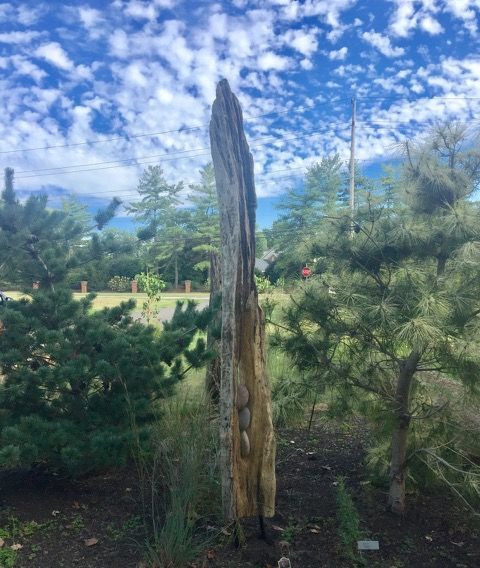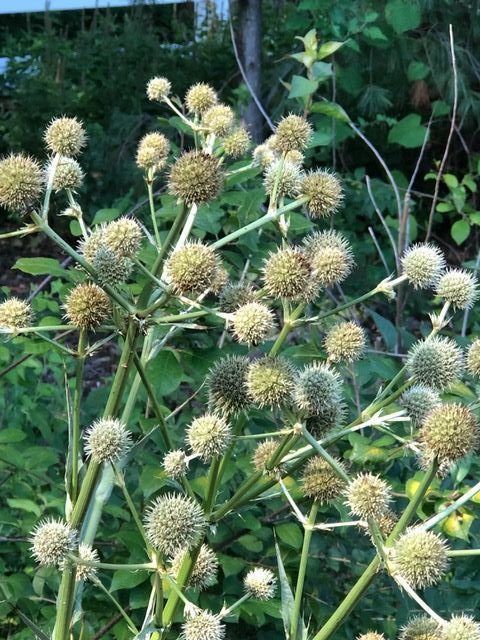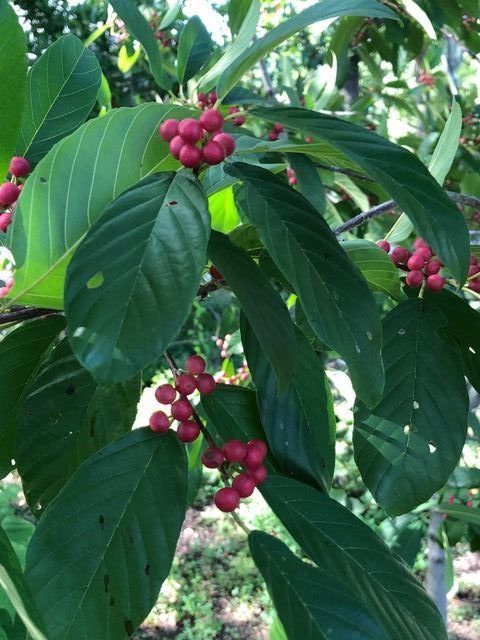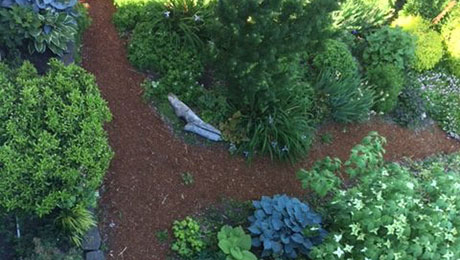Today we’re visiting the garden of Deirdre Gallagher.
After establishment, this garden is designed to require very little water. Although it is still quite young, it is attracting many birds, bees, and insects. It provides me endless joy.
One of the many goals of a wildlife habitat is to provide food for birds and other critters by planting species that insects will feed and lay eggs on. Milkweed provides nectar and a place for monarchs to lay their eggs. Look at the big seedpods. I believe this specimen is called “big hairy balls.” Clearly, this is not the scientific name (editor’s note: Gomphocarpus physocarpus,
Zones 8–10 or as annual).
This is a bouquet of flowers taken from my garden in early October when the flowers were scarce but the berries were appearing.
I am lucky enough to have a stand of wild persimmon trees (Diospyros virginiana,
Zones 4–9) in my yard. Here is the first harvest.
My yard is also certified as a monarch way station. In late fall these prairie blazing stars (Liatris pycnostachya,
Zones 3–9) attract dozens of butterflies. In wildlife gardening, we don’t do a winter clean up; all plant materials, leaves, and seedpods are left for the birds and other wildlife for cover and food. We intentionally plant berry- and fruit-bearing trees and shrubs to feed our little creatures.
I live in St. Louis. About five years ago I purchased a midcentury house that was sold as a tear-down and didn’t get torn down. In addition to redesigning the house for aging in place, I gutted the yard of invasive honeysuckle and winter creeper and began to create a wildlife habitat with help from the St. Louis Audubon Society. Part of this project involved removing large sections of the lawn. This picture shows a large circle of lawn that was removed, with evergreens (not native but for screening and avian shelter) planted on this mound and with totems made from wood fished out of the Missouri River. This sets a nice tone when entering the property.
This is rattlesnake master (Eryngium yuccifolium,
Zones 3–8). These seedpods will be welcome in the late fall.
This is the beautiful and diminutive native tree Carolina buckthorn (Rhamnus caroliniana,
Zones 5–9). With its glossy green leaves and breezy habit, it is a wonderful addition to the front yard.
This native ninebark shrub (Physocarpus opulifolius,
Zones 2–8) is perfect in the back of the border, with its arched branches and delicate flowers that last until late fall.
Have a garden you’d like to share?
Have photos to share? We’d love to see your garden, a particular collection of plants you love, or a wonderful garden you had the chance to visit!
To submit, send 5-10 photos to GPOD@finegardening.com along with some information about the plants in the pictures and where you took the photos. We’d love to hear where you are located, how long you’ve been gardening, successes you are proud of, failures you learned from, hopes for the future, favorite plants, or funny stories from your garden.
If you want to send photos in separate emails to the GPOD email box that is just fine.
Have a mobile phone? Tag your photos on Facebook, Instagram or Twitter with #FineGardening!
You don’t have to be a professional garden photographer – check out our garden photography tips!
Do you receive the GPOD by email yet? Sign up here.
Fine Gardening Recommended Products
Pruning Simplified: A Step-by-Step Guide to 50 Popular Trees and Shrubs
Fine Gardening receives a commission for items purchased through links on this site, including Amazon Associates and other affiliate advertising programs.
Pruning Simplified shows you exactly how to do it. This must-have guide offers expert advice on the best tools for the job, specific details on when to prune, and clear instructions on how to prune. Profiles of the 50 most popular trees and shrubs—including azaleas, camellias, clematis, hydrangeas, and more—include illustrated, easy-to-follow instructions that will ensure you make the right cut the first time.
DeWalt Variable-Speed Cordless Reciprocating Saw
Fine Gardening receives a commission for items purchased through links on this site, including Amazon Associates and other affiliate advertising programs.
You can fit a variety of blades to this saw to cut fallen branches or prune larger limbs from trees in a pinch. It’s fast, tough, easy to use, and extremely versatile.
- 18.31 x 6.13 x 4 inches
- 1-1/8-inch stroke length
- Variable speed trigger with 0-3000 spm
DeWalt Variable-Speed Cordless Reciprocating Saw with 6-Piece Saw Blade Set
Fine Gardening receives a commission for items purchased through links on this site, including Amazon Associates and other affiliate advertising programs.
You can fit a variety of blades to this saw to cut fallen branches or prune larger limbs from trees in a pinch. It’s fast, tough, easy to use, and extremely versatile.
- 18.31 x 6.13 x 4 inches
- 1-1/8-inch stroke length
- Variable speed trigger with 0-3000 spm
- DW4856 Metal/Woodcutting Reciprocating Saw Blade Set, 6-Piece






























Comments
Very interesting! We had our property certified by the Canadian Wildlife Federation as a 'Backyard Habitat' a while or so after moving in so I was interested to see your efforts here. Would have been interested to see you persimmon trees - what do you do with all that fruit? Keep up the good work! L.
Thank you for your post this morning. It's time for me to scale back & your low maintenance wild life garden ideas appears to be the way to do this . Thank you & good luck,Joe
P.S. The totem pole phot is terrific.
Your commitment to creating and maintaining a wildlife friendly ambiance in your garden has resulted in some interesting plant choices. And, with being able to put together such a beautiful fall bouquet, there is no lack of pretty plant material... even as you do good for the critters that come to visit.
So very pretty! How do you keep your rattlesnake master in check? Last spring, we had seedlings everywhere so after the blooms were finished & before seeds were dropped, my husband cut all of them off. I hated to do that but it is too hard to get down on the ground to dig up/pull up seedlings.
Thank you for the inspiration,, Deirdre. I have just spent two hours exploring the links on the St. Louis Audubon Society. I live just south of you in Farmington and have been trying to incorporate native plants into my landscape. Your garden is lovely and unexpected in most ideas of native plants.
Thanks for showcasing some intriguing plants that are less commonly seen in ornamental gardens. But your photos show distinctive leaves, flowers and fruiting structures that surely make them garden-worthy.
Good morning fellow Missourian, Dierdra! What a wonderful surprise to see your garden photos this morning. Your native garden is beautiful to human as well as animal eyes! We share many of the same plants, and I hope you are aware of the wonderful native plant nursery that we have near Columbia, MO. I love your totem photo - never thought of using round river rocks in the crevices of logs! I'm sure you have many other natives in your yard, and hope you can share them in the future. Best wishes!
Cheryl
Very nice!
Thanks for sharing such a great piece of article. I have recently planted cherry laurel hedge. It's white creamy flowers and fruits attract wildlife. Nice!! https://www.instanthedge.com/prunus-laurocerasus-schipkaensis
Log in or create an account to post a comment.
Sign up Log in